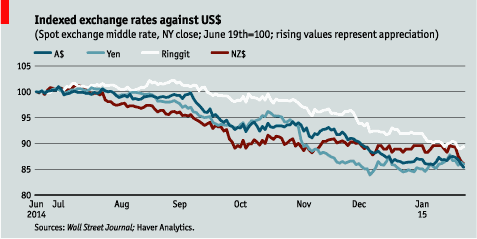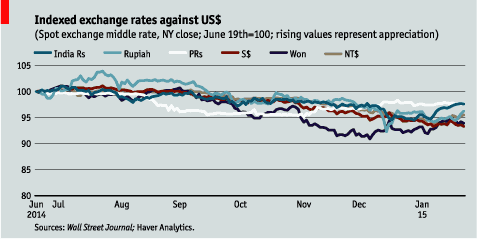
Date: 2025-08-21 Page is: DBtxt003.php txt00009108
Region ... Asia
Exchange Rates
After the oil price slump in late 2014 ... Currency wars in Asia?
Burgess COMMENTARY
Peter Burgess
Currency wars in Asia?
The recent slump in global oil prices is having a dramatic effect on many countries' terms of trade, but in Asia its effects on foreign-exchange markets have varied widely. The drop in oil prices has been associated with a general strengthening of the US dollar, but only a few Asian currencies have fallen dramatically against the dollar. Most have seen more modest declines, and a few have seen hardly any movement at all. These trends could have a significant impact on trade competitiveness within the region.
Brent crude oil prices hit US$115.15/barrel on June 19th 2014, but in subsequent months they have slumped sharply. By January 15th they had hit US$48.07/b—a slump of more than 58%. As has often been the case in the past, the fall in oil prices has been accompanied by a broad strengthening of the US currency. The US dollar not only represents a financial safe haven in troubled times, but the US's strong economic performance is in contrast to the troubled outlook in places such as Japan and the EU, making its assets look even more attractive for investors.
Currency movements can have dramatic effects on trade flows, although they generally have to be sustained for a significant period to see the full impact flow through; it takes time for export manufacturing to relocate to cheaper climes. They are also an important factor in driving inflation considerations, especially in nations that import a lot of the products that they consume. Nonetheless, the effects of exchange-rate movements are rarely simple, and often reflect country-specific factors that will complicate these generalisations. Within Asia, it is possible to group the region's currencies into three broad groups in terms of their response to the US dollar's rise: the slumpers, the sliders and the stalwarts.
Going down: the slumpers
The worst-performing currencies in Asia since June 2014 have been the Australian and New Zealand dollars, the ringgit and the yen. All have depreciated by 10% or more against the US dollar over the period.
The yen's travails are largely unrelated to the recent gyrations in the oil price. Instead, they are an intended response that the Japanese government has induced with ultra-loose monetary policy as part of a strategy to reinvigorate the country's economy. The other three countries are big commodity exporters. Some of the same factors that have dragged down the oil price—notably a glut of supply in global markets and mounting doubts about demand growth in China—have also affected the commodity markets on which their export sectors depend, making them particularly exposed. In the case of Australia and New Zealand, their currencies' declines come after a period of unusual strength against the US dollar.
Graph showing significant falls in the value of the Australian and New Zealand dollars, the yen and the ringgit, all against the US dollar, since June 19th 2014.

Easing the pain: the sliders
A much larger number of Asian currencies have fallen by a more modest amount of around 2-7% against the US dollar. These include currencies such as the Indian and Pakistani rupees, the rupiah, the won, the kyat, the New Taiwan dollar, the Singapore dollar and the togrog. This pace of depreciation is slightly less than the global average; a broad, trade-weighted exchange-rate index produced by the Federal Reserve, the US central bank, suggests an average decline of 8.8%. It is notable that the group includes some countries—such as South Korea and Taiwan—that are close competitors in many sectors. Currency movements in the last six months will not have opened up competitive advantages between such nations.
Graph showing moderate declines of Indian and Pakistani rupee, the rupiah, the Singapore dollar, won and New Taiwan dollar since June 19th 2014

Defying the trend: the stalwarts
Despite the US dollar's general strength since the oil price collapse, some Asian currencies have held up against it. The dong, the baht, the Philippine peso and the Sri Lankan rupee have all depreciated by marginal amounts, while the renminbi has even appreciated slightly since June 19th. In some cases, this may reflect the fact that central banks still intervene heavily to manage the exchange rate. Vietnam's authorities authorised a minor 1% devaluation of the dong on January 7th, but generally remain nervous about the potential inflationary impact of currency depreciation after a bout of rapid price growth in 2010‑12. In other countries, such as China and Sri Lanka, it may reflect the fact that strong economic prospects have continued to buoy investor confidence, despite the underlying nervousness that has fed the flight to US dollar-denominated assets among international investors.
Graph showing that the Philippine peso, Sri Lanka rupee, Vietnamese dong and baht have held their value vs the US dollar since June 19th 2014, while the renminbi has appreciated slightly A boost to domestic demand, but a blow to exports?
Exchange-rate trends are often influenced by country-specific factors, as well as starting points, so when seeking to draw conclusions from these different currency responses to the drop in oil prices those background circumstances need to be borne in mind. It is notable, for example, that part of the reason that currencies such as the rupiah, the Indian rupee and the Sri Lankan rupee look to be relatively strong at the moment is because they have experienced significant levels of depreciation against the US currency in the past 2-3 years. Nonetheless, some generalisations can be made.
Overall, it is notable that most Asian currencies have depreciated against the US dollar by less than the shift in its broader trade-weighted exchange rate. The boost to their trade competitiveness is therefore likely to be modest. Indeed, in markets like Japan and the euro zone, where local currencies have fallen much more steeply against the US dollar, the price competitiveness of products from many Asian countries may suffer. The erosion of competitiveness could be particularly significant for countries like China, where currencies have held their value against the US dollar.
The impact of recent currency movements will also show up in inflationary trends. The steep fall in the Australian and New Zealand dollars against their US counterpart, for example, will offset the effect of lower global oil prices in dampening local price increases. By contrast, the full (and largely beneficial) force of the oil price decline will be felt in places like the Philippines, Vietnam and Sri Lanka. In these countries, lower energy prices will allow interest rates to be kept lower for longer, while simultaneously boosting real disposable household incomes. This should help to provide a boost for domestic demand that will help to compensate for the negative effects that currency strength will have on their export sectors.
Source: Industry Briefing